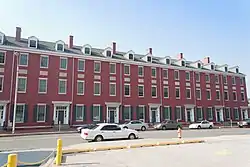Pascault Row | |
 Pascault Row, August 2011 | |
| Location | 651-665 W. Lexington St., Baltimore, Maryland |
|---|---|
| Coordinates | 39°17′28″N 76°37′35″W / 39.29111°N 76.62639°W |
| Area | 1 acre (0.40 ha) |
| Built | 1819 |
| Architect | Small, William F. |
| Architectural style | Greek Revival, Federal, Transitional |
| NRHP reference No. | 73002193[1] |
| Significant dates | |
| Added to NRHP | January 29, 1973 |
| Designated BCL | 1987 |
Pascault Row is a national historic district in Baltimore, Maryland, United States. It was built by Louis Pascault, Marquis de Poleon and consists of a range of eight 3+1⁄2-story dwellings. It is Baltimore's last remaining example of early-19th-century townhouses, and illustrates the transition between the Federal and the early Greek Revival periods. They are attributed to William F. Small, at that time employed in the architectural office of Benjamin Henry Latrobe.[2]
It was added to the National Register of Historic Places in 1973.[1]
References
- 1 2 "National Register Information System". National Register of Historic Places. National Park Service. July 9, 2010.
- ↑ Elinor D. Ehle and Catharine Black (November 1972). "National Register of Historic Places Registration: Pascault Row" (PDF). Maryland Historical Trust. Retrieved March 1, 2016.
External links
- Pascault Row at Explore Baltimore Heritage
- Pascault Row, Baltimore City, including photo from 2004, at Maryland Historical Trust
- Historic American Buildings Survey (HABS) No. MD-397, "Pascault Row, 651-665 West Lexington Street, Baltimore, Independent City, MD"
This article is issued from Wikipedia. The text is licensed under Creative Commons - Attribution - Sharealike. Additional terms may apply for the media files.

